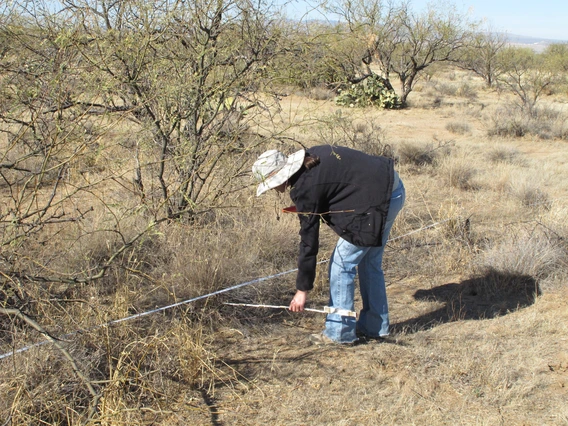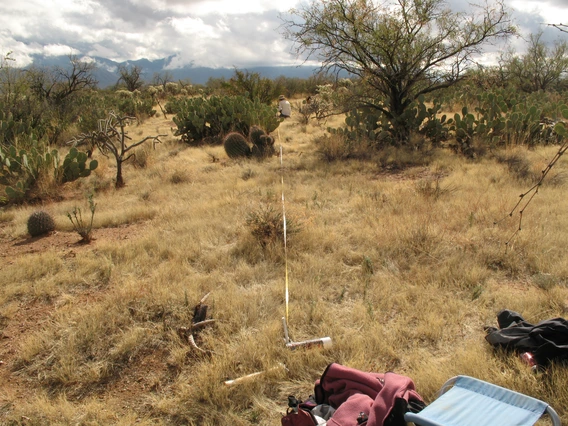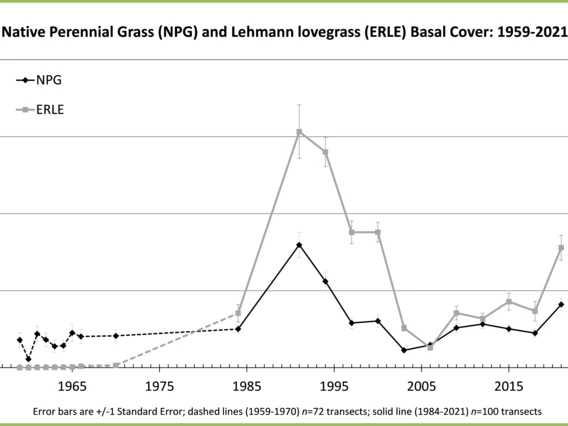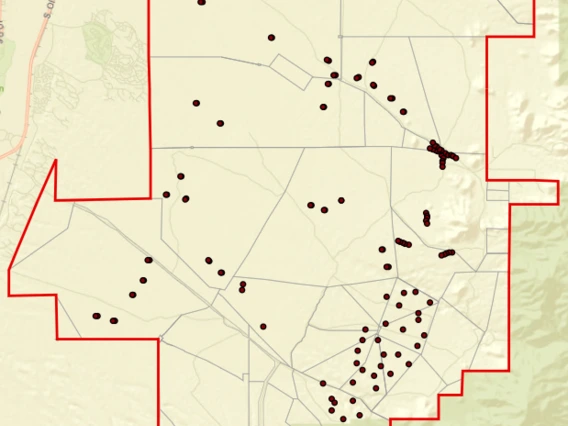The Ongoing Vegetation Transects database includes measurements of vegetation (cover, biomass, and/or density by species) for locations originally used in four experiments established by S. Clark Martin. Three of those experiments began in the 1950s and proceeded for approximately 10 years, with annual measurements of cover and biomass on permanently established plots. These experiments were designed to compare vegetation responses to different seasons of livestock grazing, the removal of velvet mesquite, and the spatial distribution of water developments for livestock use. The fourth experiment used a subset of the permanent transects from the previous three experiments and 30 new permanent transects to compare, on a large scale, the vegetation responses to continuous-yearlong grazing versus a three-pasture rotation grazing system called the Santa Rita Grazing System. This experiment lasted from 1972 to 1984, with measurements made every 3 years. Since 1991, Mitchel McClaran and his assistants at the University of Arizona have continued to measure cover, biomass, and/or density by species every 3 years on 131 transects that are a subset of the transects used in the Santa Rita Grazing System study and that are now included in the Ongoing Vegetation Transects database.
All data collected on the 131 selected transects are available for download on this website. Specifically, the pages listed below provide:
- The measurement protocols
- Measurements of vegetation by species or species group made on the study transects for cover (since 1953), density (since 1972), fetch (from 2009 to 2012), grass basal diameter converted to biomass (since 2009)
- Figures for cover, density, and perennial grass biomass
- Ecological Site Designations for the study transects
- UTM coordinates for the study transects
- Photographs of the Ongoing Vegetation Transects for viewing and downloading (since 1957)
- The original Forest Service Studies FSRM 1706- 09, FSRM 1706-12, FSRM 1706-15, and FSRM 1706-25 during which the Ongoing Transects were established.
Data users are requested to acknowledge their database use in publications, research proposals, websites, and other outlets by following the Instructions for Use, Citations, and Acknowledgement.

Ongoing Vegetation Transect Measurement Protocols
Learn more about the protocols for the long-term cover, density, and grass density and biomass measurements on the Ongoing Vegetation Transects.

Ongoing Vegetation Transect Data
Cover data from transects repeatedly measured since 1953
Density data from transects repeatedly measured since 1972
Fetch data from transects repeatedly measured between 2009-2012
Grass basal diameter and biomass data from transects repeatedly measured since 2009*
* The basal diameter of perennial grasses was not measured in 2021 due to the 2020 drought

Figures for cover, density, and perennial grass biomass for the Ongoing Vegetation Transects
Figures for cover values on 100 transects through 2024
Figures for density values on 100 transects through 2024
Figures for perennial grass biomass on 100 transects through 2024*
* The basal diameter of perennial grasses was not measured in 2021 due to the 2020 drought

UTM Coordinates and Ecological Site Designations for the Ongoing Vegetation Transects
UTM Coordinates and Ecological Site Designations are available for download for all Long-Term Vegetation Transects.

Photographs of the Ongoing Vegetation Transects since 1957 for viewing and downloading
All photographs taken since 1957 from a Vegetation Transects at the SRER can be viewed and downloaded by selecting the Transect station on an interactive map or the Transect code in a list of Pastures/Transects.

Original Source Studies
Study FSRM 1706-09: A Comparison of Vegetation Responses to Grazing Yearlong, in the Growing Season, and in the Dormant Season on Low-Value Semidesert Grass-Shrub Ranges in Southern Arizona
Study FSRM 1706-12: A Comparison of Vegetation and Grazing Capacities on Mesquite-free and Mesquite-infested Semidesert Ranges in Southern Arizona.
Study FSRM 1706-15: A Demonstration to Determine the Feasibility of Achieving Rotation-Deferred Grazing within a Single Pasture by Controlling Access to Water
Study FSRM 1706-25: Benefits of Rest March-October Two Years Out of Three












